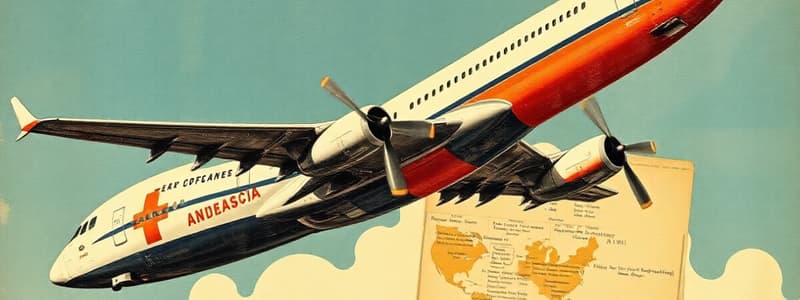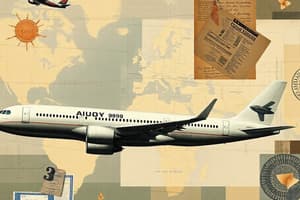Podcast
Questions and Answers
Under what regulatory framework is an Air Operator's Certificate (AOC) issued, permitting commercial aviation activities?
Under what regulatory framework is an Air Operator's Certificate (AOC) issued, permitting commercial aviation activities?
- European Union Aviation Safety Agency (EASA) regulations
- Annex 6 to the Chicago Convention
- Sec 27 of the Civil Aviation Act, CAR (1988) 206, and CASR (1998) Part 21 (correct)
- Part 91 of the Federal Aviation Regulations (FAR)
Which of the following commercial operations necessitates obtaining an Air Operator's Certificate (AOC)?
Which of the following commercial operations necessitates obtaining an Air Operator's Certificate (AOC)?
- Private flying for personal use
- Hot air balloon rides
- Gliding activities
- Agricultural operations conducted for commercial purposes (correct)
What are the implications of conducting commercial aviation activities without possessing a valid Air Operator's Certificate (AOC)?
What are the implications of conducting commercial aviation activities without possessing a valid Air Operator's Certificate (AOC)?
- It is illegal and subject to legal sanctions (correct)
- It requires only a waiver from standard operating procedures
- It is acceptable for a limited duration
- It is permissible with prior notification to CASA
According to the Civil Aviation Act 1988, under what circumstances is an Air Operator's Certificate (AOC) mandated for commercial operations?
According to the Civil Aviation Act 1988, under what circumstances is an Air Operator's Certificate (AOC) mandated for commercial operations?
What are the delineated exceptions within the Civil Aviation Act 1988 that permit commercial aviation operations without needing an Air Operator's Certificate (AOC)?
What are the delineated exceptions within the Civil Aviation Act 1988 that permit commercial aviation operations without needing an Air Operator's Certificate (AOC)?
When applying for an Air Operator's Certificate (AOC), which components of Form 1049 are considered mandatory?
When applying for an Air Operator's Certificate (AOC), which components of Form 1049 are considered mandatory?
Under what specific conditions does the mutual recognition of Air Operator's Certificates (AOCs) between Australia and New Zealand apply?
Under what specific conditions does the mutual recognition of Air Operator's Certificates (AOCs) between Australia and New Zealand apply?
What prerequisite must Australian operators fulfill before they can request operations in New Zealand under the Australian New Zealand Agreement (ANZA)?
What prerequisite must Australian operators fulfill before they can request operations in New Zealand under the Australian New Zealand Agreement (ANZA)?
What role does the Secretary of the Department play in the process of granting an Australian Air Operator's Certificate (AOC) with ANZA privileges?
What role does the Secretary of the Department play in the process of granting an Australian Air Operator's Certificate (AOC) with ANZA privileges?
What is one of the primary responsibilities of a Registered Operator (RO) to ensure compliance with regulatory aviation standards?
What is one of the primary responsibilities of a Registered Operator (RO) to ensure compliance with regulatory aviation standards?
What documentary evidence do Air Operator's Certificate (AOC) holders need to possess as proof of adequate passenger liability insurance coverage?
What documentary evidence do Air Operator's Certificate (AOC) holders need to possess as proof of adequate passenger liability insurance coverage?
Prior to permitting an aircraft to fly, what must a Registered Operator (RO) ensure regarding continuing airworthiness?
Prior to permitting an aircraft to fly, what must a Registered Operator (RO) ensure regarding continuing airworthiness?
Under what conditions can an aircraft with a defect be permitted to operate, according to aviation regulations?
Under what conditions can an aircraft with a defect be permitted to operate, according to aviation regulations?
What key details must the flight technical log include for aircraft operation, particularly concerning inoperative or non-required equipment?
What key details must the flight technical log include for aircraft operation, particularly concerning inoperative or non-required equipment?
What is the primary function of the Configuration Deviation List (CDL) in aviation operations?
What is the primary function of the Configuration Deviation List (CDL) in aviation operations?
What is the established criterion that mandates a Maintenance Organisation to possess Part 145 approval to conduct maintenance on an aircraft?
What is the established criterion that mandates a Maintenance Organisation to possess Part 145 approval to conduct maintenance on an aircraft?
What principle governs the application of Approved Maintenance Programs to aircraft operated by Continuing Airworthiness Management Organisations (CAMOs)?
What principle governs the application of Approved Maintenance Programs to aircraft operated by Continuing Airworthiness Management Organisations (CAMOs)?
In the context of aviation maintenance, what is the pivotal role of CASR Part 42, focusing especially on the management and execution of continuous airworthiness?
In the context of aviation maintenance, what is the pivotal role of CASR Part 42, focusing especially on the management and execution of continuous airworthiness?
According to aviation regulations, what specific actions must a Continuing Airworthiness Management Organisation (CAMO) undertake before allowing an aircraft to fly?
According to aviation regulations, what specific actions must a Continuing Airworthiness Management Organisation (CAMO) undertake before allowing an aircraft to fly?
What document requirements does CAR 139 specify that a pilot in command must ensure are onboard the aircraft during flight?
What document requirements does CAR 139 specify that a pilot in command must ensure are onboard the aircraft during flight?
Flashcards
What is an Air Operator's Certificate (AOC)?
What is an Air Operator's Certificate (AOC)?
An Air Operator's Certificate is a permission granted by CASA to conduct commercial aviation activities under specified regulations.
Is an AOC always required?
Is an AOC always required?
Operating commercial aviation activities without an Air Operator's Certificate is illegal and punishable by law.
What is 'aerial work'?
What is 'aerial work'?
Includes aerial surveying, spotting, agricultural operations, photography, advertising and ambulance functions.
Flying Training and AOC
Flying Training and AOC
Signup and view all the flashcards
What is 'Charter' in aviation?
What is 'Charter' in aviation?
Signup and view all the flashcards
What is Regular Public Transport (RPT)?
What is Regular Public Transport (RPT)?
Signup and view all the flashcards
When is an AOC required?
When is an AOC required?
Signup and view all the flashcards
When is an AOC not required?
When is an AOC not required?
Signup and view all the flashcards
Mandatory Parts of AOC Application Form
Mandatory Parts of AOC Application Form
Signup and view all the flashcards
Mutual Recognition of AOCs (ANZ)
Mutual Recognition of AOCs (ANZ)
Signup and view all the flashcards
Registered Operator (RO) Responsibilities
Registered Operator (RO) Responsibilities
Signup and view all the flashcards
Proof of Passenger Liability Insurance
Proof of Passenger Liability Insurance
Signup and view all the flashcards
Operator's Airworthiness Responsibilities
Operator's Airworthiness Responsibilities
Signup and view all the flashcards
Permitted Operation with Aircraft Defect
Permitted Operation with Aircraft Defect
Signup and view all the flashcards
What is a Minimum Equipment List (MEL)?
What is a Minimum Equipment List (MEL)?
Signup and view all the flashcards
CASR Subpart 42.C
CASR Subpart 42.C
Signup and view all the flashcards
CAMO Obligations
CAMO Obligations
Signup and view all the flashcards
Requirements for CAMO Approval by CASA
Requirements for CAMO Approval by CASA
Signup and view all the flashcards
Documents Carried in Australian Aircraft
Documents Carried in Australian Aircraft
Signup and view all the flashcards
Required Aircraft Markings
Required Aircraft Markings
Signup and view all the flashcards
Study Notes
Air Operator's Certificates
- An Air Operator's Certificate (AOC) is needed to conduct commercial activities under regulations like Sec 27 of the Civil Aviation Act, CAR (1988) 206, and CASR (1998) Part 21.
- It is illegal and punishable by law to operate commercial activities without an AOC, and all AOCs are issued for a specified term.
- An AOC is required for commercial purposes such as aerial work, flying training, charter, and Regular Public Transport (RPT).
Aerial Work
- Defined under CAR 206 and includes aerial surveying, spotting, agricultural operations, photography, advertising, and ambulance functions.
- Aerial work also includes carriage for trading purposes, of goods owned by the pilot, owner, or hirer, not available to the general public, on schedules that are not fixed to and from fixed terminals
Flying Training
- An AOC is needed for flying training, except for conversion training or training under an experimental certificate per CASR Part 21.
Charter
- Defined as the carriage of passengers or cargo for hire or reward, not under fixed schedules or a Special Flight Permit.
- An AOC is needed for carriage with fixed schedules to and from fixed terminals when the aircraft is not available to the public.
Regular Public Transport (RPT)
- Regular Public Transport (RPT) involves transporting persons or cargo for hire or reward on fixed schedules between specific terminals, with or without intermediate stops.
Air Operator's Certificates Requirements
- Per Section 27 of the Civil Aviation Act 1988 and CAR 206, an AOC is required for aircraft flying into, out of, or within Australian territory, and for Australian aircraft flying outside Australian territory.
- Commercial operations can occur without an AOC for limited category aircraft (e.g., joy flights) and experimental aircraft (practice flights).
Application for an AOC
- To get an AOC, operators need to complete an AOC Application Form (Form 1049), which has nine parts (A to I) and guidelines for each part.
- Mandatory parts include details of the applicant(s) (Part A), main and ancillary bases/facilities (Part F), and organizational structure/personnel (Part G).
Australia and New Zealand Mutual Recognition of AOCs
- Australia and New Zealand mutually recognize AOCs for aircraft with over 30 seats or exceeding 15,000 kg.
- Mutual recognition allows operators from either country to operate in the other based on their home certification.
- Australian operators need to apply to CASA under the Australian New Zealand Agreement (ANZA), and CASA must ensure the AOC holder operates high-capacity aircraft registered in Australia or New Zealand.
- CASA needs advice from the Secretary of the Department that the applicant is eligible for an Australian AOC with ANZA privileges, according to the Civil Aviation Act 1988.
Registered Operator (RO) Responsibilities
- The RO must comply with safety regulations and ensure employees/flight crews know local laws.
- A Compliance Statement evaluates an applicant’s Operations Manual and Maintenance Control Manual.
- AOC holders need a current Certificate of Compliance from CASA as proof of passenger liability insurance.
Continuous Airworthiness and Maintenance Responsibilities
- Before an aircraft can fly, the RO must ensure continuous airworthiness by rectifying defects, complying with Airworthiness Directives, making approved modifications and repairs, and replacing life-limited products.
- Compliance with an Approved Maintenance Program, measuring its effectiveness, ensuring serviceability of required equipment, and having a valid Airworthiness Review Certificate (ARC) is essential, and a CRS is needed for any maintenance performed.
- The flight technical log must detail any unserviceable operational or emergency equipment not required by the aircraft's approved design or regulations.
Aircraft Defects
- If an aircraft has a defect, operation is allowed if permitted by the Minimum Equipment List (MEL), Configuration Deviation List (CDL), or a Special Flight Permit (SFP).
Minimum Equipment List (MEL)
- The Minimum Equipment List (MEL) is a CASA-approved document based on the TC holder's MMEL.
- It specifies conditions for aircraft operation with inoperative equipment and provides timeframes for rectifying faults relative to their operational significance.
Configuration Deviation List (CDL)
- The Configuration Deviation List (CDL) identifies any external aircraft parts missing at the start of a flight.
Dispatch Deviation List/Guide
- The Dispatch Deviation List (DDL), also known as the Dispatch Deviation Guide (DDG), contains both the MEL and CDL.
Aircraft Maintenance Program Responsibilities
- CASR Subpart 42.C outlines continuous airworthiness requirements, including aircraft and aeronautical product maintenance, and covers the requirements for a Continuing Airworthiness Management Organisation (CAMO).
- CASA is authorized to issue a MOS for CASR Part 42, and a Maintenance Organisation must have Part 145 approval to perform aircraft maintenance.
- CASR Part 42 applies only to Australian aircraft and their aeronautical products under a Regular Public Transport (RPT) AOC. The CAMO must have an Approved Maintenance Program for each aircraft.
- The Maintenance Program details scheduled tasks, their frequency, and necessary procedures, such as a Reliability Program, aircraft should comply to one approved maintenance program at a time. A transfer check or inspection may be needed when changing programs.
Maintenance Program Reviews
- The Maintenance Program details must be reviewed at least annually, along with revisions of documents affecting its basis.
- Mandatory requirements for Part 21 compliance should be incorporated into the owner's or operator's Maintenance Program as soon as possible.
Continuing Airworthiness Management Organisation (CAMO)
- CASR Part 42 distinguishes managing airworthiness of an RPT aircraft (CAMO) from actual maintenance (Part 145 Organisation). An RPT operator (AOC holder) must be approved as a CAMO and is responsible for the continuing airworthiness.
- A registered air transport operator must have aircraft maintenance and products done by approved individuals/organizations; only a Part 145 approved Maintenance Organisation can perform the maintenance.
CAMO Obligations
- Before an aircraft can fly, a CAMO must ensure maintenance and certification are done by an Approved Part 145 Organisation.
- A CAMO must ensure compliance with Airworthiness Directives, approved modifications/repairs, replacement of life-limited products, and compliance/effectiveness of the Approved Maintenance Program.
- Maintenance of an aircraft's airworthiness record system, the use of a technical log with flight/maintenance status and a CRS issued upon maintenance completion are also CAMO obligations.
- All equipment required by regulations must be serviceable and fitted, and a valid Airworthiness Review Certificate (ARC) is mandatory. A CAMO approval does not authorize maintenance.
CAMO Tasks
- Aircraft cannot fly before specific airworthiness tasks are completed, and CAMOs must ensure both continuing airworthiness and the serviceability of operational/emergency equipment.
- This can be done by accomplishing pre-flight inspections, rectifying or deferring defects to recognized standards with approved data, and governing by MEL, CDL, and SRM requirements.
- Defects must be fixed if they impact safety, but they can be deferred if they do not.
CAMO Approval Requirements
- To be approved as a CAMO by CASA, an organization must have adequate facilities/equipment, access to airworthiness instructions (maintenance data), qualified personnel, and an exposition detailing processes/procedures.
- CASR Part 42 Subpart G outlines initial approval and changes, and Part 42 MOS specifies requirements for facilities, equipment, and personnel.
Documents to Be Carried in Australian Aircraft (CAR 139)
- The pilot in command must carry the Certificate of Registration, Certificate of Airworthiness, Maintenance Release or CRS, licenses and medical certificates of the crew, the flight manual (if any), and any radio equipment license.
- If there are passengers, a list of their names, embarkation/disembarkation points; if there is cargo, the bills of lading and manifests must be carried.
Aircraft Markings (CASR Part 45)
- Australian aircraft must have permanently attached markings/signs inside and out, including nationality/registration marks, identification plates, and identifying words.
- CASR Part 45 has rules on nationality and registration marks, and it includes information on the meaning, location, size, spacing, and how they are affixed to the aircraft.
Nationality and Registration Marks Details
- Nationality marking—VH.
- Registration marking—a group of characters (e.g., ABC).
- The Nationality and Registration Marking are separated by a hyphen, e.g. VH—ABC - some aircraft may be exempt.
Identification Plates
- CASR Part 45 includes rules for fireproof aircraft registration plates that withstand fire as well as steel.
- It must be marked with "VH," a hyphen, and the registration mark by etching, stamping, engraving, or another approved method.
- The plate must be accessibly attached near an entrance, secured against defacement or detachment.
- Operating without this plate or removing it without CASA's approval is an offence.
Identifying Words
- CASR Part 45 requires certain aircraft to bear words if they are covered by restrictions, meaning the aircraft doesn't meet approved airworthiness standards, they alert passengers to the fact.
- These words are: LIMITED (for Limited category), RESTRICTED (for Restricted category), PROVISIONAL (for Provisional Certificate of Airworthiness), and EXPERIMENTAL (for Experimental category).
Safety Signs
- Australian aircraft must display safety placards for crew and passengers that include: no smoking, fasten seatbelts, fire extinguisher locations, life jacket locations, exits, emergency exits and break-in points.
- Designated fuselage areas for break-in by rescue crews must be marked, outlined in white to contrast, and if corner markings are over 2m apart, intermediate lines (9cm x 3cm) must be added.
Placards
- Placards are essential parts that have part numbers and are in the Illustrated Parts List/Catalogue, many are part of the type design.
- They are often safety aids in a legible condition, with many covered by Airworthiness Directives (ADs), and they can mark inoperative equipment, bigger planes have a list in their procedure checklists.
Studying That Suits You
Use AI to generate personalized quizzes and flashcards to suit your learning preferences.





